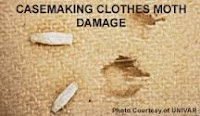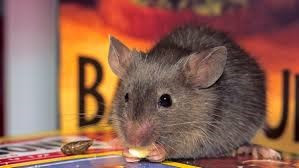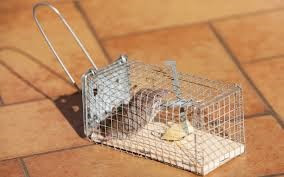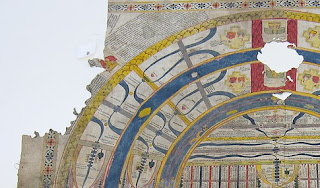Pascal Querner Researcher, University of Natural Resources and Applied Life Sciences, Austria
My backgrounds; Conservation background qualified with undergraduate in Art History followed by MA in Conservation in 1992 work as a freelance conservator mainly for the National Galleries of Scotland. Also Project Manager of HLF Funded SFF project, Opening Up Scotland’s Archives for the Scottish Council on Archives. I’ve been a member of UKRG for 4 years and two years ago volunteered in Registrars Department at National Galleries of Scotland to gain more experience and completed the Diploma on Art Professional Law and Ethics in 2014
Pascal started his talk with brief introduction about himself and said that he loved art but loves pests more. The talk continued at a fast pace with lots of good humour to keep you alert and take in all the information. Pascal explained the term Integrated Pest Management which many people will be familiar with, however, useful to have bullet point references. We focused on how pests are transported into gallery and museum environment and lastly responses to pest problems. Reiterating several times throughout the presentation that Prevention is the best approach to pest management.
All museums and galleries should have an Integrated Pest Management Programme which will centre on Prevention, Monitoring and if necessary Treatment.
There were some people sitting in the room didn’t think their museum or gallery had pests but according to Pascal every environment will have some present as Museums and galleries as they provide a food source, a warm and protective environment and offer safety from their predators. It’s fairly easy for pests to get into building, if’s it old they are probably already present, but they come through doors, windows, holes in the floorboards or skirting boards. Often they are unwittingly transported by visitors or in new acquisitions or borrowed objects and paintings for exhibitions.Pests can be unintentionally moved around the museum and offsite when objects and packaging materials are transported. A good point made by Pascal that it is not only old museum objects but modern art that can also have pest problems.
It’s something we can’t ignore as pests don’t only damage the art or museum objects, but are a health risk for museum workers, visitors and an environmental hazard.
Obviously, prevention is the long term solution to avoiding a pest problem and if possible appoint a pest management coordinator who will be responsible for continuous monitoring of pests, sealing the building and reducing the chances of entry, climate control, training staff, oversee good housekeeping and cleaning practices. If pests are found they need to be identified, locate the infestation and evaluate the problem and selecting the best treatment method.
Pascal showed a slide of a flow diagram depicting the five stages of control measures and their relationship. It’s taken from Agnes Brokerhof’s work on IPM and clearly illustrates the assessment and management of Pests Risks in Collection.
Identification is paramount and we saw slides of hugely magnified insects, reminiscent of a 1950’s B movie where giant cockroaches were taking over the world.
Pascal spoke of pests found in museums and galleries all over the world, and depending on the climate and location, each country will have their particular problematic pests. In the UK commonly found pests, include;
Silverfish and firebrats that prefer starchy foods and will eat fabrics, paper and sizing, and the glue and paste in older book bindings.

The Beetle: usually of these three: Lyctidae (true powderpost beetles that cannot digest cellulose and attack the sapwood of hardwood only), Bostrichtidae (false powderpost beetles that attack both soft and hardwood), and Anobiidae (anobiid, furniture, and deathwatch beetles that attack both soft and hardwood, and prefer to feed on sapwood).
Rodents can do an immense amount of damage to collections, particularly paper and textiles which can be chewed and ripped up for nesting materials. Prevention of a rodent problem is easier than trying to remove it
or else…….
In the past a method of controlling pests involved the use of Pesticides. It is not recommended as a long term solution as there can be serious health risks. – Pascal knows of 2 incidents of death as the result of long term exposure to pesticides. There is also a high risk of damaging and causing corrosion of art material due to pesticides.
What do we do when we discover pests?
If you do find anything, isolate it immediately and then think about your options. The video clip shows a picture (with a new wooden frame) on loan to the National Galleries of Scotland. As you would expect there was a condition report sent with the picture and a conservator at NGS checked the paperwork and object. During the exhibition, warders at NGS noticed powder on the carpet which turned out to be frass. The Pest Management Officer at NGS, Keith Morrison was alerted and when he examined the picture he noticed a very small black hole and something was moving. He grabbed his iPhone and using his handheld magnifying glass recorded the woodworm making its first appearance into daylight.
The picture was immediately removed from the Gallery and isolated. All pictures were thoroughly examined, but none other were contaminated. The owners of the picture were contacted and it was agreed to return it to them for treatment.
Treatment Options
Pascal advocated the use of a nitrogen chamber or tent, however, the downside is it takes 5 weeks to complete the treatment. It is a specialist treatment and has cost implications. A somewhat cheaper and very effective alternative and widely used treatment in the UK is freezing. I asked Pascal a questions, ‘is it safe to use a nitrogen chamber with all museum objects and paintings?’ Pascal said that there can be a change to the pigment Prussian Blue which can be reversed. Nitrogen can in some cases contribute to growth of microorganisms with nitrogenase enzymes that help fix nitrogen as a fuel source. More research is needed in this area to clarify this potential issue.
Freezing is another very popular treatment and cost effective.
Safe for almost all organic and composite materials, relatively time-efficient and a low cost after initial investment for freezer.
Unlike, using a nitrogen tent or chamber, preparing objects for freezing does not entail extensive staff training or staff time for maintenance during procedure.
Speaking as a conservator, care should be taken with fragile, composite or unstable materials and recommended to seek advice from an expert. The type of freezer is important, ideally reducing the temperature to minus 29 degrees centigrade within 4 hours. Typical low-temperature treatment for infestation involves freezing for a minimum of 72 hours, several older publications recommend repeated freeze/thaw cycle(s) as a precaution, but recent work indicates that one longer treatment at a low enough temperature should suffice.
After removal from the freezer, objects should be allowed to acclimate to room temperature, still completely wrapped, until they are at room temperature, at least 24 hours.
Near the end of the presentation, Pascal focused on something which will be of particular interest to exhibition registrars. It was various examples of pests entering the museum environment on materials used in the transportation and protection of objects, including new picture frames.
Examples:
Wood pallets used to carry and store art objects. Infected with a beetle and this can transfer its attention to the museum object. This has occurred around ten times in Pascal’s career.
Textile Blankets, used to wrap objects and painting. Can be infected with the common cloth moth. Think about using synthetic blankets or have a policy to clean and freeze the blankets once or twice a year.
Transportation boxes – 12 months’ life cycles of a beetle, very quick and can affect an object or painting in storage – includes new wooden picture frames. Please see short film.
It’s important to always be alert and aware.
Must have active monitoring – just like monitoring RH and temperature.
Any new acquisitions must be checked for pests before they are stored next to existing parts of the collections.
In summary:
Pascal Querner gave a very good and entertaining introduction to Integrated Pest Management. He has many years of experience working as a pest management consultant and was able to give real life examples of pest problems and was very happy to answer questions from the audience. He concluded his presentation by reiterating that IPM is a long term programme, and not any good only doing it for one year. The next IPM Conference will be held in September 2016 in Paris at the Louvre, and he hopes that some of the audience will be attending.
Pascal recommends reading ‘Integrated Pest Management for Cultural Heritage’, by
More information can be found:
Thank you to UKRG for giving me a bursary towards the cost of attending the 2016 European Registrars Conference in Vienna. I would also like to thank, Keith Morrison at the National Galleries of Scotland for discussing the IPM work at NGS including Duff House.
By Audrey Wilson BA(Hons) in the History of Drawing & Printmaking, MA in Conservation.
Dip APLE (London)

 Instagram
Instagram  LinkedIn
LinkedIn  Twitter
Twitter  My Account
My Account 






